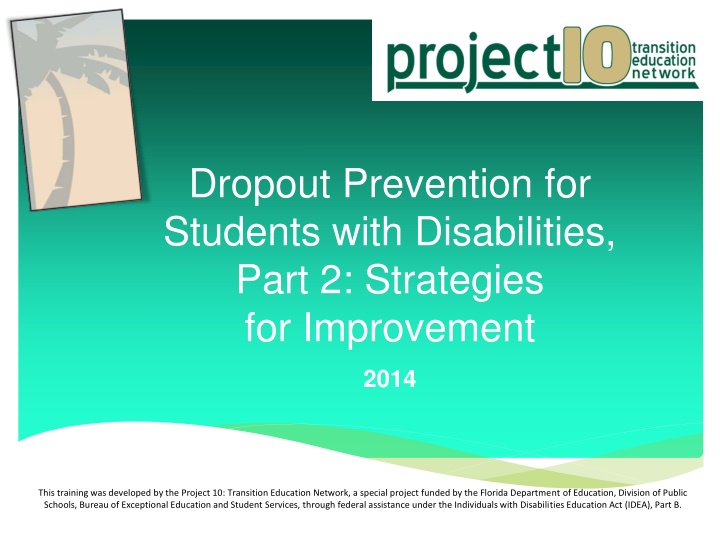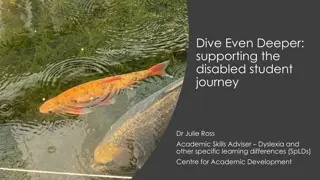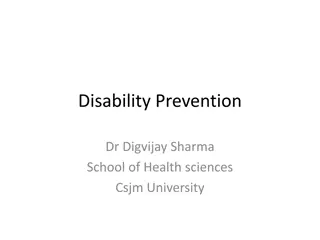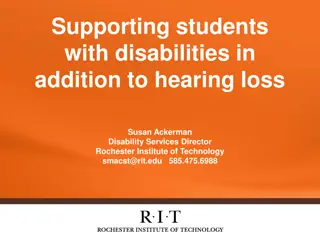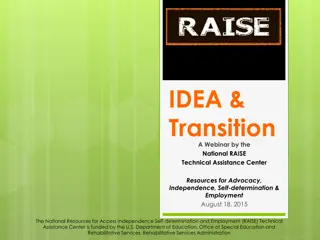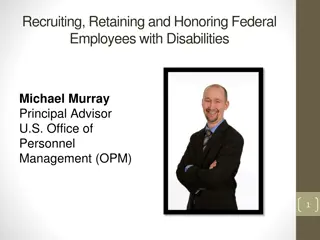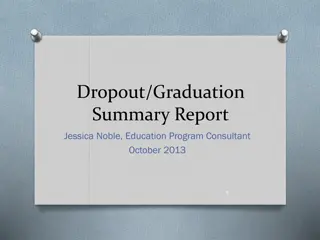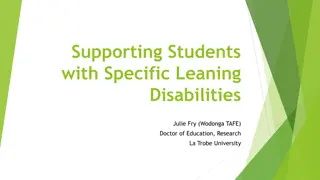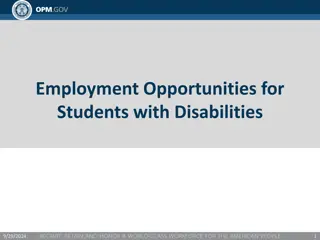Dropout Prevention Strategies for Students with Disabilities
This training program, developed by Project 10: Transition Education Network and funded by the Florida Department of Education, focuses on strategies to prevent dropouts among students with disabilities. Topics include graduation success, tools for dropout prevention, and resources such as Attendance Works to improve attendance and reduce chronic absence.
Download Presentation

Please find below an Image/Link to download the presentation.
The content on the website is provided AS IS for your information and personal use only. It may not be sold, licensed, or shared on other websites without obtaining consent from the author.If you encounter any issues during the download, it is possible that the publisher has removed the file from their server.
You are allowed to download the files provided on this website for personal or commercial use, subject to the condition that they are used lawfully. All files are the property of their respective owners.
The content on the website is provided AS IS for your information and personal use only. It may not be sold, licensed, or shared on other websites without obtaining consent from the author.
E N D
Presentation Transcript
Dropout Prevention for Students with Disabilities, Part 2: Strategies for Improvement 2014 This training was developed by the Project 10: Transition Education Network, a special project funded by the Florida Department of Education, Division of Public Schools, Bureau of Exceptional Education and Student Services, through federal assistance under the Individuals with Disabilities Education Act (IDEA), Part B.
Going Green! You can find a copy of this presentation at the Project 10 Transition Education Network s website, www.project10.info 1
Topics Section 1: Graduation Success and Dropout Prevention Tools Section 2: Check & Connect, State Professional Development Grant (SPDG) Section 3: Florida s Effective Practices 2
Section 1: Graduation Success and Dropout Prevention Tools 3
Graduation Success and Dropout Prevention Tools Attendance Works BoostAttendance Campaign Early Warning System (EWS) Everyone Graduates Center GradNation Community Guidebook 4
Attendance Works Attendance Works provides key strategies, tools and technical assistance, research, news, and webinars designed to improve attendance and reduce chronic absence http://www.attendancew orks.org/ 5
Attendance Works Tools 1. Calculating Chronic Absences 2. Attendance Messaging 3. Superintendents Call to Action 4. Campaign for Grade-Level Reading 6
Attendance Works Tools, continued... 5. Attendance Presentations 6. Working with Parents Bringing Attendance Home Toolkit 7. Working with Teens and Their Families 8. Schools 7
Attendance Works Tools, continued 9. Afterschool Providers 10. Early Education Providers 11. Healthcare Providers 12. School Districts 13. Leveraging Volunteers and National Service 8
Attendance Works Tools, Conclusion 14. City Leaders 15. Workshops and Keynotes 16. Peer Learning Network 17. Technical Assistance 9
BoostAttendance Campaign BoostAttendance provides a calculator, tips for success, a Text2Track program for parents, and campaign materials ALL FREE designed to improve attendance Visit www.boostup.org for more information 10
The reality is an absence is an absence, excused or not, and that child is not in that classroom benefiting from the instruction on that day. We have to work in our community, with our schools and our families to build a culture of attendance." Ralph Smith, Executive Vice President, Annie E. Casey Foundation 11
Early Warning System (EWS) National High School Center EWS High School Tool EWS Middle Grades Tool EWS Implementation Guides EWS Community of Practice Self-Assessment Tool http://www.betterhighschools.org/ews.asp 12
District and School Self- Assessment Tool The National High School Center s self-assessment provides district and school personnel a tool to evaluate and develop areas of focus for improving district practices http://www.betterhighschoo ls.org/AssessmentTool/doc uments/EightElementsSelf AssessmentTool.pdf 16
Self-Assessment: Areas of High School Improvement 1. Rigorous Curriculum and Instruction 2. Teacher Effectiveness and Professional Growth 3. Stakeholder Engagement 4. Organization and Structure 5. Assessment and Accountability 6. Student and Family Involvement 7. Effective Leadership 8. Sustainability 17
Learning What It Takes Report Everyone Graduates Center Learning What it Takes Report An initial look at how schools are using early warning indicator data and collaborative response teams to keep all students on track to success http://new.every1graduates.org/learnin g-what-it-takes/ 18
EWS, National Dropout Prevention Center Students with Disabilities Building Early Warning Systems to Identify Students with Disabilities at Risk for Dropping out of High School and Monitoring their Response to Intervention http://www.ndpc-sd.org/dissemination/teleseminars.html 19
Grad Nation Community Guidebook The Grad Nation Community Guidebook provides resources and tools to help community and schools raise graduation rates and better prepare young people for success http://guidebook.americasp romise.org/ 20
Grad Nation Community Guidebook Tools Tool 1: What s at Stake Tool 2: 2013 Building a Grad Nation Annual Report Presentation Tool 3: State and Community Profile Tool 4: Graduation Rate Methods Tool 5: Estimating Graduation Rates in Your Community Tool 6: Dropout Profiles Related to Attendance, Credits, Credit Accumulation, Age, Withdrawal 21
Grad Nation Community Guidebook Tools Tool 7: Individual High School Dropout Transcript Analysis Tool 8: School Performance Trends for Dropouts and/or Withdrawals with Unknown Destinations Tool 9: Attendance Survey Tool 10: Surveys About Students Classroom and School Experiences Tool 11: Policy Audit 22
Grad Nation Community Guidebook Tools Tool 12: College and Career Ready Tool 13: Comprehensive Community Solutions Tool 14: Asset Mapping for Individuals and Organizations Tool 15: Key Data for an Early Warning System Tool 16: Community Representatives Chart 23
Section 2: Florida s Check & Connect State Professional Development Grant (SPDG) 24
Floridas Check & Connect Check & Connect is a model of sustained intervention for promoting students engagement at school and with learning Implemented by a trained mentor Checks on students Connects with students 25
Check & Connect Outcomes Demonstrated outcomes of Check & Connect include: Increased attendance, persistence in school, accrual of credits and school completion rates Decreased truancy, tardiness, behavioral referrals and dropout rates 26
Check & Connect Core Elements 1. Mentor 2. Check 3. Connect 4. Engaging with family 27
Florida Check & Connect, 2013-14 Levy Williston High, Williston Middle Hendry Labelle Middle, Labelle High, Clewiston Middle, Clewiston High Polk Tenoroc High, Crystal Lake Middle Pinellas Northeast High, Dixie Hollins High, Meadowlawn Middle, Pinellas Park Middle 28
Florida Check & Connect, 2014-15 Charlotte Punta Gorda Middle, Port Charlotte Middle, Murdock Middle, Port Charlotte High, Charlotte High Dade Norland Middle, Riveria Middle, Norland High, Southwest High DeSoto DeSoto Middle, DeSoto High Gadsden West Gadsden High, East Gadsden High, James Quincy Middle, Carter Paramore Academy Hillsborough Pierce Middle, Sligh Middle, Leto High, Middleton High Jefferson Jefferson Middle/High Okeechobee Okeechobee High, Okeechobee Freshman Campus Taylor Taylor Middle, Taylor High, Taylor Alternative School 29
Check & Connect Resources Check & Connect flyer http://checkandconnect.umn.edu/docs/CheckandConnectFl yer.pdf Introductory video http://checkandconnect.umn.edu/model/overview_register.h tml Effective Dropout Preventions in A Practice Brief for Educators http://www.ndpc- sd.org/documents/Practice_Guides/CBI_Practice_Brief.pdf 30
Floridas Check & Connect Contacts Lael Engstrom, Check & Connect Project Manager, at University of South Florida St. Petersburg (USFSP), Project 10 Office lengstrom@mail.usf.edu Peg Sullivan, Co-Director SPDG, at Florida Gulf Coast University (FGCU) msulliva@fgcu.edu 31
Section 3: Florida s Effective Practices 32
Floridas Effective Practices Florida s Effective Practices corresponding with: IDEA Transition Indicators National Dropout Prevention Center/Network (NDPC/N) Strategies Institute of Educational Sciences (IES) Recommendations 33
IDEA Transition Indicators The four transition indicators are: Graduation Rate (Indicator 1) Dropout Rate (Indicator 2) Secondary Transition IEPs (Indicator 13) Postschool Outcomes (Indicator 14) 34
National Dropout Prevention Center/Network Strategies The 15 NDPC/N dropout prevention strategies are: 1. Systemic renewal 2. School-community collaboration 3. Safe learning environments 4. Family engagement 5. Early childhood education 6. Early literacy development 7. Mentoring/tutoring 8. 9. 10. After-school opportunities 11. Professional development 12. Active learning 13. Educational technology 14. Individualized instruction 15. Career/Technical Ed Service-learning Alternative schooling 35
Institute of Educational Sciences (IES) Recommendations The six IES dropout prevention recommendations are: 1. Utilize data systems 2. Assign adult advocates 3. Provide academic support and enrichment 4. Implement behavior and social skills programs 5. Personalize learning environment and instruction 6. Provide rigorous and relevant instruction 36
Summary Both in FL and Nationally, our students with disabilities are: Comparable on types of risk factors, reasons for dropping out, & responsiveness to evidence- based practices NOT comparable on graduation or dropout rates ! More work to be done Evidence-based resources available! 37
Presenter Contact Information (RTR Name) Project 10: Transition Education Network Region ( ) Transition Representative Email: Office: Updated October 2014 39
References Alliance for Excellent Education. (2012). Student engagement in high school as a dropout prevention. Retrieved from http://www.all4ed.org/events/studentengagement_HSdropoutprevention Attendance Works. (2012). Advancing student success by reducing chronic absence. Tools and T.A. Retrieved from http://www.attendanceworks.org/ Center for Comprehensive School Reform and Improvement, The. (2012). Professional learning communities. Retrieved from http://www.centerforcsri.org/plc/elements.html Coca-Cola. (2012). Valued youth program. Retrieved from http://livepositively.com/en_us/cocacola_valued_youth_program?WT.srch=1#/cocacola_valued_youth_program Education Northwest. (2012). Creating small learning communities. Retrieved from http://educationnorthwest.org/resource/913 FLDOE/BEESS. (2012). Performance plan for 2005-2013 (Revised Feb. 2012). Retrieved from http://www.fldoe.org/ese/ FDOE. (2011). Exit interview student survey data. Source: Survey 5 2010-11 (as of 10.17.11) & 2009-10 (as of 2.25.11). Author: Tallahassee, FL. FLDOE/BEESS. (2011). SEA profile. Retrieved from http://www.fldoe.org/ese/datapage.asp FDOE. (2010). High performing districts 2005-2010. Author: Tallahassee, FL. FDOE. (2008-09). Florida public high school graduation and dropout rates, 2008-09. Retrieved from http://www.fldoe.org/eias/eiaspubs/ FDOE. (2008). Identifying and reporting dropouts for grades PK-12 school year 2008-2009 (Technical Assistance Paper). Retrieved from http://www.fldoe.org/eias/dataweb/tech/dropout.pdf GraduateFIRST. (2012). Retrieved from http://www.graduatefirst.org/ 40
References, continued Hammond, C. (2007). Dropout risk factors and exemplary programs: A technical report. Retrieved from http://ndpc-web.clemson.edu/major- research-reports/dropout-risk-factors-exemplary-programs-technical-report Institute on Community Integration. (2012). Check and connect: A comprehensive student engagement intervention. Retrieved from http://checkandconnect.org/ Institute on Community Integration. 2012). Dropout prevention and student engagement. Retrieved from http://ici.umn.edu/index.php?topics/view/3/ Mentor: National Mentoring Partnership. (2012). Expanding the world of quality mentoring. Retrieved from http://www.mentoring.org/ National Center for Educational Statistics. (2012). Trends in high school dropout and completion rates in the United States: 1972-2009. Retrieved from http://nces.ed.gov/pubsearch/pubsinfo.asp?pubid=2012006 National High School Center. (2010). Quick stats fact sheet: High schools in the United States (March 2009). Retrieved from http://www.betterhighschools.org/pubs/#Facts National High School Center. (2009). What matters for staying on-track and graduating in Chicago public schools: A focus on students with disabilities. Retrieved from http://www.betterhighschools.org/docs/NHSCCCSRSpecialEd.pdf National High School Center. (2007). High school dropout: A quick stats fact sheet. Retrieved from http://www.betterhighschools.org/pubs/documents/NHSC_DropoutFactSheet.pdf National High School Center. (2007). State approaches to more reliable and uniform dropout and graduation data. Retrieved from http://www.betterhighschools.org/pubs/usergd_stapp.asp National High School Center. (n.d.). Early warning systems for high school and middle grades. Retrieved from http://www.betterhighschools.org/documents/NHSC_EWSBrochure.pdf National Dropout Prevention Center/Network. (2012). Model programs. Retrieved from http://www.dropoutprevention.org/modelprograms 41
References, continued National Dropout Prevention Center/Network. (2012). Publications. Retrieved from http://www.dropoutprevention.org/publications National Dropout Prevention Center/Network. (2012). Radio webcast. Solutions to the dropout crisis. Retrieved from http://www.dropoutprevention.org/webcast National Dropout Prevention Center Students with Disabilities. (2008). Areas of academic engagement overview. Retrieved from http://www.ndpc-sd.org/documents/Teleseminars/12.graduatefirst/Areas-of-Engagement.pdf National Dropout Prevention Center/Network. (2007). Dropout risk factors and exemplary programs: A technical report. Retrieved from http://www.dropoutprevention.org/home Project 10 Transition Education Network. (2012). Dropout prevention. Retrieved from Sarlo, R. (2011). The role of engagement in maximizing achievement and graduation outcomes. Presentation delivered at the 2011 Educational Strategies & Student Engagement Institute. Complete the Journey: Paving a Path to Success, St. Petersburg, FL. Southwest Educational Development Laboratory, The. (2012). What is a PLC? Retrieved from http://www.sedl.org/pubs/sedl- letter/v19n01/what-is-a-plc.html U.S. Department of Education, National Center for Education Statistics. (2011). The Condition of Education 2011 (NCES 2011-033),Table A-20-1. Retrieved from http://nces.ed.gov/fastfacts/display.asp?id=16 U.S. Department of Education, ED.gov. (2012). Ed data express: Data about elementary & secondary schools in the U.S. retrieved from http://www.eddataexpress.ed.gov/data-element-explorer.cfm/tab/data/deid/1844/ U.S. Department of Education, ED.gov. (2012). EDFacts/Consolidated state performance report, 2009-10. Retrieved from http://www2.ed.gov/admins/lead/account/consolidated/index.html 42
